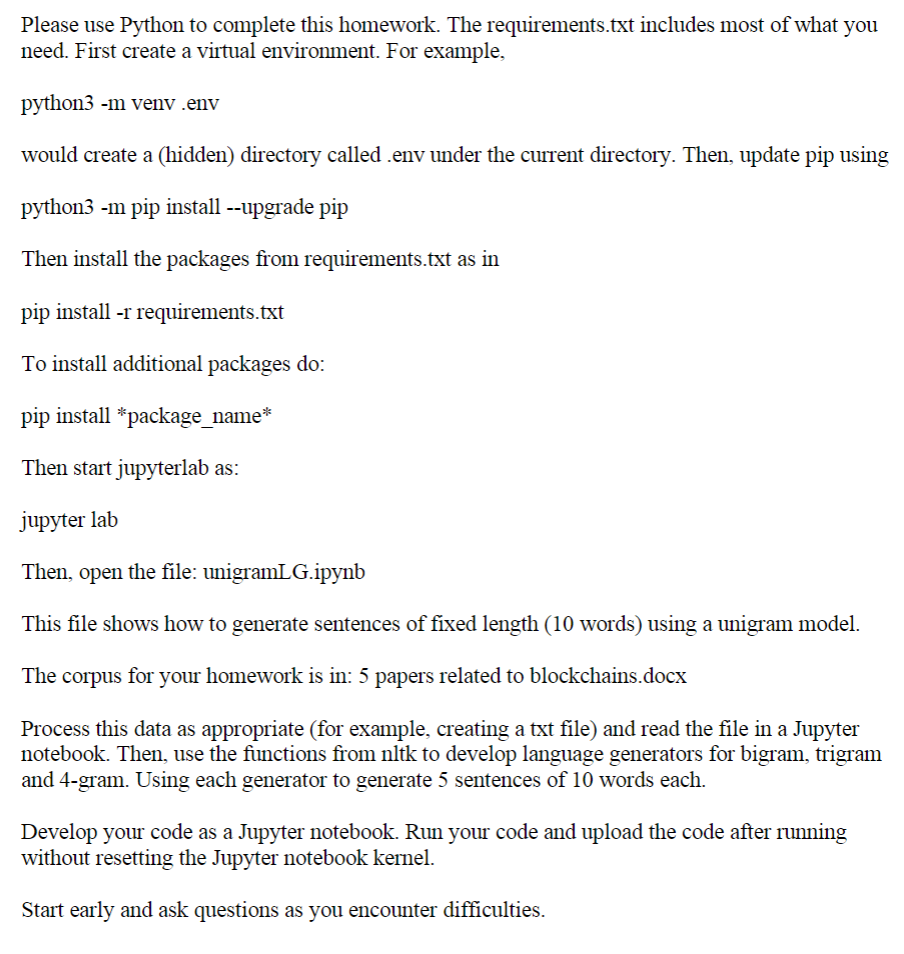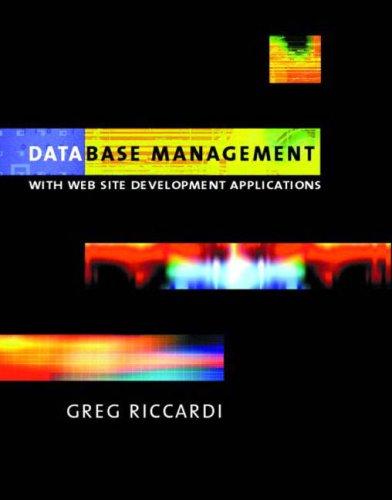Answered step by step
Verified Expert Solution
Question
1 Approved Answer
PLEASE MAKE SURE TO INCLUDE GENERATING AND PRINTING A 10 WORD SENTENCE FROM EACH MODEL Requirements.txt below Part Of Corpus Below Link To Full Corpus

PLEASE MAKE SURE TO INCLUDE GENERATING AND PRINTING A 10 WORD SENTENCE FROM EACH MODEL
Requirements.txt below

Part Of Corpus Below
Link To Full Corpus Doc > https://docs.google.com/document/d/1lfDlMsN2e9IX2D5u3q3mPl2ptubnaeb5/edit?usp=sharing&ouid=104284312092576826275&rtpof=true&sd=true

Please use Python to complete this homework. The requirements.txt includes most of what you need. First create a virtual environment. For example, python 3 -m venv .env would create a (hidden) directory called .env under the current directory. Then, update pip using python3 -m pip install --upgrade pip Then install the packages from requirements.txt as in pip install -r requirements.txt To install additional packages do: pip install *package_name* Then start jupyterlab as: jupyter lab Then, open the file: unigramLG.ipynb This file shows how to generate sentences of fixed length (10 words) using a unigram model. The corpus for your homework is in: 5 papers related to blockchains.docx Process this data as appropriate (for example, creating a txt file) and read the file in a Jupyter notebook. Then, use the functions from nltk to develop language generators for bigram, trigram and 4-gram. Using each generator to generate 5 sentences of 10 words each. Develop your code as a Jupyter notebook. Run your code and upload the code after running without resetting the Jupyter notebook kernel. Start early and ask questions as you encounter difficulties. beautifulsoup 4==4.11.1 html 5lib==1.1 jupyterlab==3.4.5 lxml==4.9.1 matplotli.b==3.5.3 nltk ==3.7 numpy ==1.23.2 panda.s ==1.4.4 spacy =3.4.1 urllib3 ==1.26.12 Towards a Framework for Understanding the Performance of Blockchains M. Touloupou, K. Christodoulou, A. Inglezakis, E. Iosif and M. Themistocleous, "Towards a Framework for Understanding the Performance of Blockchains," 2021 3rd Conference on Blockchain Research \& Applications for Innovative Networks and Services (BRAINS), 2021, pp. 47-48, doi: 10.1109/BRAINS52497.2021.9569810. Abstract - Blockchain and Distributed Ledger Technology (DLT) appears to be at a worldwide threshold of acceptance and adoption. Since their inception, several innovative projects have been proposing solutions to the blockchain trilemma, improving blockchain features and its technical limitations. However, the adoption of blockchain as a technology or a software component, requires a comprehensive understanding and characterization of their technical principles and characteristics. The latter introduces an uncertainty for an organization to decide which blockchain protocol best meets its needs and demands. In general, there is a lack of proper testing and software engineering practices for assessing the usage of blockchains usage and understanding their performance. Towards that direction, this paper presents an architecture for a blockchain benchmarking framework which aims at the deployment and evaluation of different blockchain protocols, focusing on different aspects such as security and scalability. A set of modules is introduced for testing and evaluating the behaviour of blockchain protocols under different test scenarios. A distributed ledger is often described as a shared distributed database which is accessed and maintained by a set of independent, possibly untrusted participants (i.e., nodes). Each participant owns an identical copy of the database of transactions (i.e., the ledger) maintained over a peer-to-peer (p2p) network. All modifications or additions to the ledger are expressed immediately and agreed among the participants using a consensus algorithm. Blockchain, which is considered as a type of a Distributed Ledger Technology (DLT), was first introduced within the concept of a cryptocurrency (i.e., Bitcoin), while by then has received a lot of attention due to the unique characteristics it offers, i.e. security, anonymity, transparency, and decentralization [1]. The decentralized nature of a blockchain, lacks of a central authority to synchronize the state of the processes. For this reason, such systems implement consensus algorithms, which are responsible for (i) the coordination of the distributed nodes, and (b) the validation of the state of transactions propagated in the network. Moreover, consensus algorithms provide reliability and liveness to the network and defend it against malicious (aka byzantine) attacks. Nowadays, blockchain technology has been introduced as a software component in many domains such as healthcare, supply chain, finance, and energy [2], while many enterprises and academic institutions are conducting research on how blockchains can be used for solving real-world challenges (e.g., identity theft, mismanagement in healthcare, digital copyright \& piracy issues etc.). Still though, the wide adoption of the technology still remains an ongoing task. On the technical side, choosing which blockchain protocol to deploy, and which type (public, private or consortium) is challenging. Before deciding which blockchain protocol to deploy several questions need to be explored such as: Why a blockchain infrastructure is required? How is the blockchain infrastructure improving current processes? Which blockchain protocol is suitable based on the requirements at hand? and to what extend does the selected blockchain protocol handles security and scalability concerns? In an attempt to answer the aforementioned questions, this paper introduces an architecture for a proposed blockchain
Step by Step Solution
There are 3 Steps involved in it
Step: 1

Get Instant Access to Expert-Tailored Solutions
See step-by-step solutions with expert insights and AI powered tools for academic success
Step: 2

Step: 3

Ace Your Homework with AI
Get the answers you need in no time with our AI-driven, step-by-step assistance
Get Started


